Trestle Table – Project Info
Posted 29 April 2015
This is the introductory page for a paid video series. Want to watch more of this project? Select the best option below to get started.
Description
This trestle dining table is a design that Paul first came up with when making a dining table as a wedding present for one of his sons. It features houndstooth dovetails on the corners of the apron and three vertical columns at each end, as well as a waney edge on the table top. Paul makes a table that can seat up to 8 people, but this design can be adjusted to whatever you may want to make, such as a coffee table or side table.
Preparing Stock for a Table
We have produced two videos that will help you to understand the wood preparation for this project.
The tools you will need are:
- Chisels: 1/4″, 3/8″, 1/2″, 3/4″, 1″
- Chisel hammer
- Smoothing Plane (No 4)
- Jack Plane* (No 5)
- Hand router
- Spokeshave
- No.80 Cabinet scraper
- File/rasp
- Dovetail saw
- Tenon saw
- Panel saw
- Knife (Stanley)
- Pencil
- Square awl
- Philips screwdriver
- Cordless drill driver (or hand drill) & bits
- Tape measure
- Engineers combination square
- Marking gauge
- Mortice gauge
- Dovetail template
- Mortice guide
- Clamps (5 x 48” and 8 x 36”)
The joints used in this project:
- Houndstooth dovetail
- Stopped mortice and tenon
- Through mortice and tenon with round-over
- Through mortice and tenon with housing and round-over

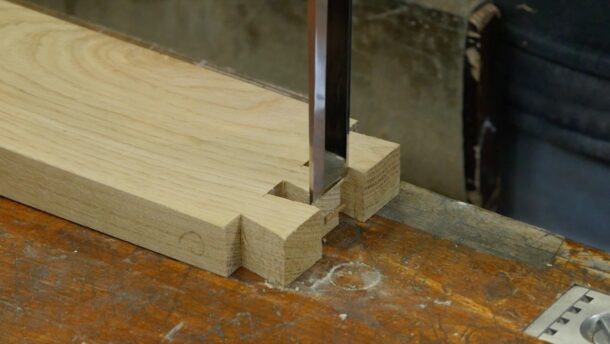
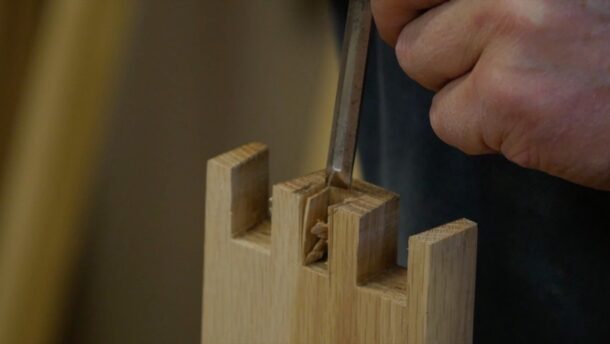
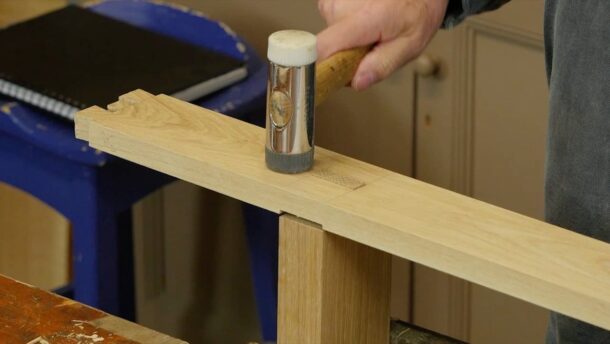
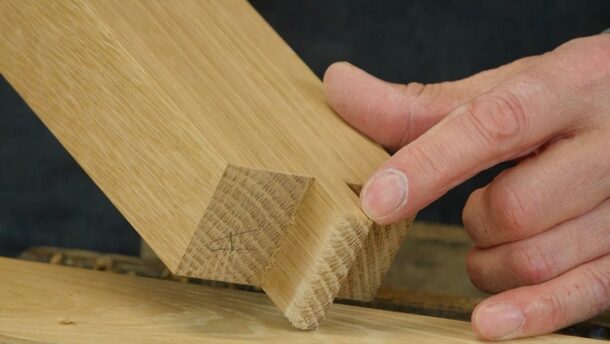
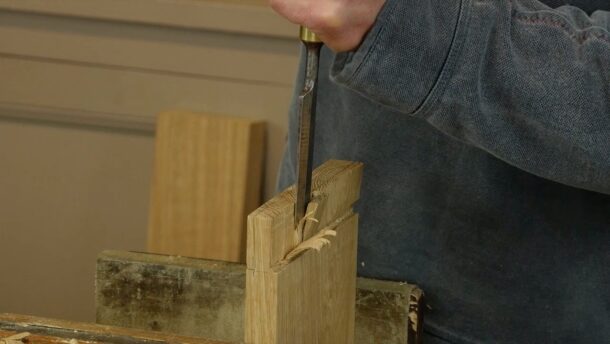
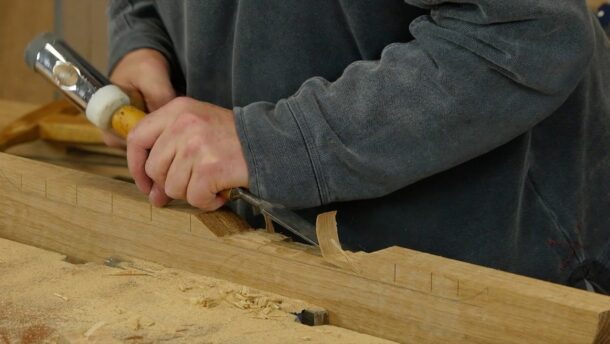
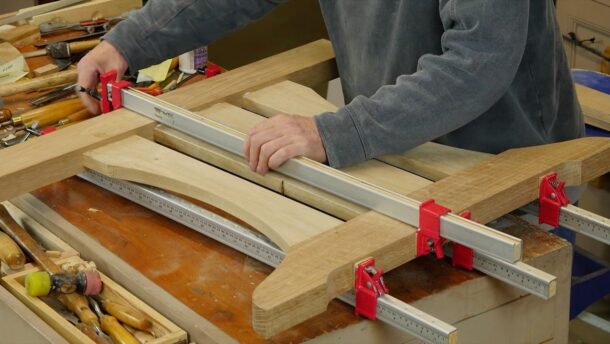
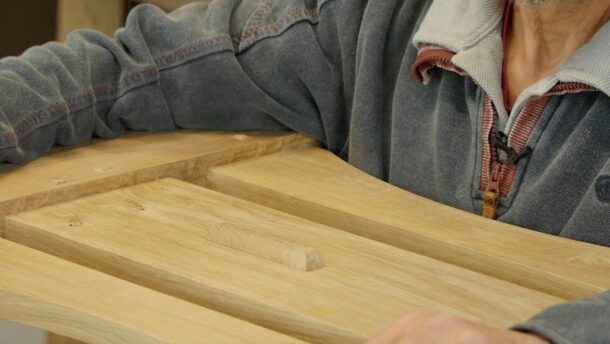
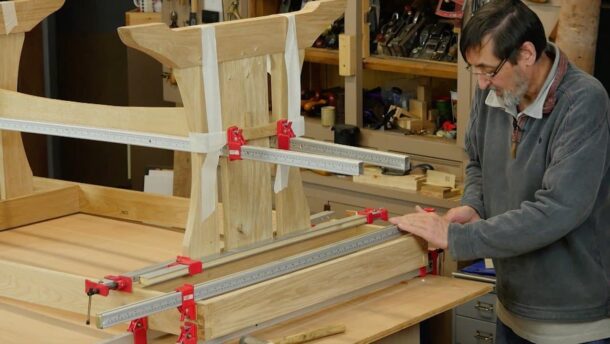
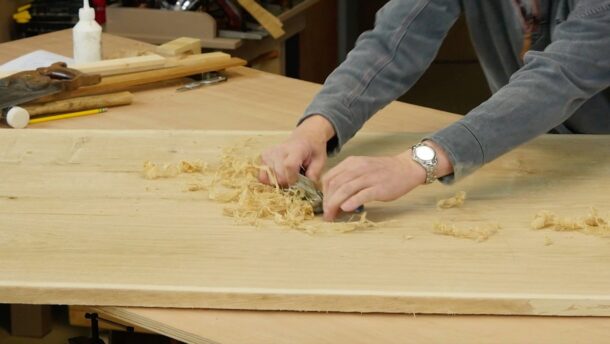
I had seen this design in the form of a coffee table on your site before (I think) and I like it a lot. I was excited to see this build come up.
I’d like to resize this back to the coffee table size. Can you provide any pointers on changing the size while keeping the dimensions.
Also, the coffee table looked to have the trestles flush to the apron at the ends, which I really like. How would you go about doing that?
Paul,
I have really enjoyed watching this trestle table come together. I am wanting to make a coffee table sized version out of walnut. (I have noticed a version of this on your website here.)
Would it be possible to share the materials and cut list, as well the adaptions necessary?
Thanks,
Joshua
We do make this project as part of a course that we have taught, but the plans and specific dimensions aren’t currently available.
You could do a full sized or scale drawing to establish dimensions you are happy with. The uprights are tenoned into the apron instead of the crossmember.
Sorry to not be more helpful.
How easy would it be to adapt the design to reduce the size of the apron? I’m looking to get kids high-chairs underneath it and not sure from the video how flexible the apron size can be. Thanks for your help! Nick
Hello Nick,
If you reduce the width of the apron, you can make up for it by increasing the thickness. The other thing you can do is move it further in from the edge a little which may be a benefit in your situation?
Best, Phil
Thanks Phil – I think moving the apron in about 8 inches from all the sides would work ok, so long as it would still be stable as a table? Nick
Paul reckons that will be fine.
Hi – table looks great.
I have a rather ambitious dining idea with some Cedar (a lebanon Cedar fell down on my brother’s farm and the wood has been seasoning in a neighbour’s woodshop for nearly 8 years now)
There are pieces from the trunk of this tree roughly slabbed that are about 10-12 foot long, 12- 18 inches wide, +/- 3 inches thick.
The same brother will be renovating a large farm building in the coming years, that will have a common space crying out for a huge, long table, and I want to use this wood to make him a very large dining table.
Quite aside from the “fun” I am going to have preparing this stock, I have two questions:
– I want to maintain the live / wany edge to the table top as per Paul’s design here, but not have the aprons so visible. Especially as the table top itself will already be quite thick. It is ok to back the aprons off from the edge a little- say 6-8 inches?
– Is there any real advantage in solidity to using breadboard ends on the top of a trestle table like this? Or is that a bit belt-and-braces with the frame underneath?
(I should point out that I am a long way off actually making this table both in terms of my skills and the building it is going into being ready for a table! All practise practise for now. I am however very excited about using that cedar wood- I am visiting him in a few weeks and will have a look at its condition…)
replying to my own question – now I notice that one of my questions is already answered by Philip above! great that the aprons could be so far in from the table edge.
Hi Hugh,
Sounds like a great project. Paul said that it would be hard to use breadboard ends to keep it flat (depends somewhat on final thickness). You’re better off letting it settle for a few years once made and then seeing if it needs re-flattening. It shouldn’t move much after that.
Best, Phil
Hi –
Ok great, thanks for the reply. Will do some small practise ones in the meantime and at least prove to myself that I could tackle the bigger project…
look forward to getting stuck in.
Hi guys,
A friend has asked me to build this table for him. How long would you expect it to take, to build it?
Thanks,
Dario
Dario,
Episode play total is 7 1/2 hrs.
Multiply x 4 ~= 30 hrs.
My guess, if your wood is already acclimated in your shop would be 1 1/2 weeks working 8 hrs / day.
Really just a wild guess.
Best,
Craig
Hi Craig,
Thanks for your estimate. How did you get from 30 hours to 60 hrs (1.5 weeks)?
Dario
Takes time for the finish to dry???
I guessed.
Craig
A few people have built this. Look in the projects part of the forum and send them a message, perhaps?
Paul has a coffee table version of this design that he uses in class. It is both smaller and simpler in a few details. He handed us milled wood. Even so, after 6 full days, I’d say two out of about six people had finished construction and the rest had about a day of work left before being ready to start finishing. On a full sized table like this, ignoring milling the wood, some things like legs and aprons probably don’t take too much longer to do, but I’d expect laminating and leveling the top to take more than proportionally longer and the same for finishing. I’d guess Craig’s 60 hours could be right if you move things along, but does not include finishing and may not include milling. I’m probably the worst person at estimating work times, so don’t take this too seriously. If you are hand milling the wood, I have no idea what to add. Check the dimensions on this table for passthrough on your doors.
Great. Thanks for the replies. 60 hrs sounds good enough as a working estimate. I buy sawn timber and use a bandsaw and planer/thicknesser to rough dimension the wood.
Thanks,
Dario
How many BF did Paul use for this project? I didn’t see it listed anywhere.